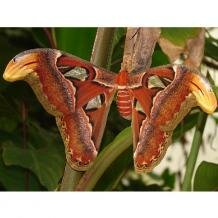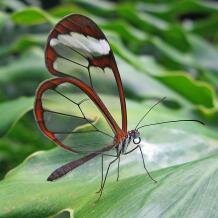Topic: Corneal nipple arrays in insect eyes
Anti-reflection coating? Not only on mobile phone displays, but also on insect eyes...
Eyes naturally possess a refracting surface – without it, image formation would be impossible. However, if the transition in the refractive index is sharp, reflections might be produced, which can impair image quality. Furthermore, a bright glare from an animal’s eye might alert predators. Therefore, some insects have evolved anti-reflection devices in the surface of their compound eyes that show a number of intriguing convergences…
Structure and functioning of corneal nipples
In the 1960s, electron microscopy of the compound eyes  of the sphingid moth Prodenia eridiana revealed a highly ordered array of conical protrusions on the corneal cuticle. It was subsequently shown that this so-called corneal nipple array (or moth-eye array) serves to reduce reflectance of the eye surface. The nipples basically work as a kind of impedance transformer between air and lens, mimicking a material of intermediate refractive properties (as the protuberances are smaller than the wavelengths of visible light, they do not scatter light and do not interfere with image formation). At the nipple tip, the refractive index is that of air, whereas the index equals that of the lens at the nipple base. This results in a gradual transition in the refractive index and conveys a broadband anti-reflection effect. The crucial factor for reducing reflection is nipple height. Hence, three height classes were established – only class II (50-200 nm) and class III (>200 nm) nipples are anti-reflective, whereas class I nipples (<50 nm) are not. Corneal surface patterns vary widely among insect groups, but anti-reflective nipple arrays are widespread and have probably evolved more than once.
of the sphingid moth Prodenia eridiana revealed a highly ordered array of conical protrusions on the corneal cuticle. It was subsequently shown that this so-called corneal nipple array (or moth-eye array) serves to reduce reflectance of the eye surface. The nipples basically work as a kind of impedance transformer between air and lens, mimicking a material of intermediate refractive properties (as the protuberances are smaller than the wavelengths of visible light, they do not scatter light and do not interfere with image formation). At the nipple tip, the refractive index is that of air, whereas the index equals that of the lens at the nipple base. This results in a gradual transition in the refractive index and conveys a broadband anti-reflection effect. The crucial factor for reducing reflection is nipple height. Hence, three height classes were established – only class II (50-200 nm) and class III (>200 nm) nipples are anti-reflective, whereas class I nipples (<50 nm) are not. Corneal surface patterns vary widely among insect groups, but anti-reflective nipple arrays are widespread and have probably evolved more than once.
Corneal nipples in Lepidoptera and Trichoptera
 Corneal nipple arrays are best known from moths and butterflies (Lepidoptera). Here, the nipples are arranged in a hexagonal, almost crystalline fashion, with distances varying only slightly among species. Nipple heights, however, differ considerably, and while the anti-reflective class II and class III nipples have been reported from most families, numerous species have low nipples or none at all (e.g. the swallowtail butterflies in the family Papilionidae). Anti-reflective nipples are particularly widespread in the nocturnal moths (e.g. Antheraea and Attacus), which led to the suggestion that the nipple array serves to enhance light sensitivity by decreasing the proportion of photons that are reflected off the eye surface. But this transmittance increase seems to be only minor, so it was proposed that reducing the conspicuous glare from the eye could protect the moths from predation during the day, when they are inactive and therefore vulnerable. However, experimental evidence for this camouflage hypothesis is still lacking, and corneal nipples are also found in many diurnal butterfly species.
Corneal nipple arrays are best known from moths and butterflies (Lepidoptera). Here, the nipples are arranged in a hexagonal, almost crystalline fashion, with distances varying only slightly among species. Nipple heights, however, differ considerably, and while the anti-reflective class II and class III nipples have been reported from most families, numerous species have low nipples or none at all (e.g. the swallowtail butterflies in the family Papilionidae). Anti-reflective nipples are particularly widespread in the nocturnal moths (e.g. Antheraea and Attacus), which led to the suggestion that the nipple array serves to enhance light sensitivity by decreasing the proportion of photons that are reflected off the eye surface. But this transmittance increase seems to be only minor, so it was proposed that reducing the conspicuous glare from the eye could protect the moths from predation during the day, when they are inactive and therefore vulnerable. However, experimental evidence for this camouflage hypothesis is still lacking, and corneal nipples are also found in many diurnal butterfly species.
In the tiny coffee leaf miner moth (Leucoptera coffeella), the cornea has a strongly convex curvature due to the small size of the lenses,  and the eye operates near the lower diffraction limit. Here, corneal nipples are virtually absent. Instead, the outer corneal surface is equipped with a regular arrangement of ridges radiating from the centre to the periphery of each lens. Such microridges are easier to construct than corneal nipples and equally effective as anti-reflective structures. They have been found in the eyes of other tiny flying insects (e.g. some flies) and resemble the ridges located on butterfly scales that help to create UV patterns.
and the eye operates near the lower diffraction limit. Here, corneal nipples are virtually absent. Instead, the outer corneal surface is equipped with a regular arrangement of ridges radiating from the centre to the periphery of each lens. Such microridges are easier to construct than corneal nipples and equally effective as anti-reflective structures. They have been found in the eyes of other tiny flying insects (e.g. some flies) and resemble the ridges located on butterfly scales that help to create UV patterns.
Apart from lepidopterans, corneal nipple arrays are also prominent in the caddisflies (Trichoptera) and, intriguingly, can even be detected in fossil specimens enclosed in amber. Electron microscopy of 40-50 million years old caddisflies from the Eocene revealed the presence of a well-preserved hexagonal array of high protuberances on their compound eyes, very similar in size and structure to the corneal nipples of extant caddisflies.
Corneal nipples in other insects
 It was originally assumed that corneal nipples are confined to evolutionarily advanced insect groups, but high protuberances are also found in Thysanura, the basal order that includes silverfish and firebrats, and earwigs in the genus Forficula. The eyes of the crepuscular earwigs are coated with nipples that are similar to those of Attacus moths with respect to height, but lack their regular spacing. The latter might make them less efficient, but they still fulfil the physical conditions necessary for functioning as anti-reflective devices.
It was originally assumed that corneal nipples are confined to evolutionarily advanced insect groups, but high protuberances are also found in Thysanura, the basal order that includes silverfish and firebrats, and earwigs in the genus Forficula. The eyes of the crepuscular earwigs are coated with nipples that are similar to those of Attacus moths with respect to height, but lack their regular spacing. The latter might make them less efficient, but they still fulfil the physical conditions necessary for functioning as anti-reflective devices.
Corneal nipple arrays have furthermore been detected in a number of other insects. In the nocturnal grasshopper Epacromia dorsalis, the arrangement is similar in height and spacing to that of Antheraea moths, and also the nipples of the nocturnal eusocial wasp Provespa barthelemyi are comparable to those found in moths. Uniquely, not only the lenses but even the gaps between them are coated with high nipples in this hymenopteran. In the larval stage, the diurnal mayflies in the genus Cloeon are aquatic, but then develop into a short-lived aerial adult. Related to the physical differences between water and air, corneal nipples are only present in the imago and subimago (a winged, usually sexually immature form that undergoes a final moult), whereas the eye surface of nymphs is smooth. Interestingly, the nipples vary in height and spacing in different regions of the eye, but the optical significance of this remains unknown.
Further convergences
In addition to the repeated evolution of nipple arrays on the surface of insect eyes,  there are much wider points of interest in the context of evolutionary convergence. Unlike most lepidopterans, pellucid hawk moths (Cephonodes hylas) and glasswings (Greta oto) have transparent wings without scales. Transparency is achieved by tiny protuberances on the wing surface that are strikingly similar to the corneal nipple arrays (in glasswings, even with respect to the change in refractive index). These protuberances, which possess a circular shape in hawk moths and a pyramidal one in glasswings, are packed in a highly ordered hexagonal arrangement. Experiments in hawk moths showed that an artificial wing without protuberances reflected up to 50% more light than an intact wing. The anti-reflective transparent wings are likely to provide some protection from visual predators or parasites.
there are much wider points of interest in the context of evolutionary convergence. Unlike most lepidopterans, pellucid hawk moths (Cephonodes hylas) and glasswings (Greta oto) have transparent wings without scales. Transparency is achieved by tiny protuberances on the wing surface that are strikingly similar to the corneal nipple arrays (in glasswings, even with respect to the change in refractive index). These protuberances, which possess a circular shape in hawk moths and a pyramidal one in glasswings, are packed in a highly ordered hexagonal arrangement. Experiments in hawk moths showed that an artificial wing without protuberances reflected up to 50% more light than an intact wing. The anti-reflective transparent wings are likely to provide some protection from visual predators or parasites.  Similar structures have been found on the wings of some cicada species (e.g. Psaltoda claripennis, Tamasa tristigma and Cicadetta oldfieldi), where they probably serve the same function during the all-important but brief aerial reproductive phase, as well as other insects such as termites, where they may also assist with strengthening and possibly self-cleaning.
Similar structures have been found on the wings of some cicada species (e.g. Psaltoda claripennis, Tamasa tristigma and Cicadetta oldfieldi), where they probably serve the same function during the all-important but brief aerial reproductive phase, as well as other insects such as termites, where they may also assist with strengthening and possibly self-cleaning.
Some marine animals have gone one step further and achieved transparency of the whole body based on the same principle – their body surface is not smooth but studded with minute pimples. According to where on the surface the light falls, the refractive index changes seamlessly from tips (where it is the same as the water) to the base (here the index equals that of the animal), so the net result is a dramatic reduction in surface reflectivity.
Not surprisingly, the anti-reflective properties of nipple arrays have attracted the attention of technologists. Applications include windowpanes, camera lenses and mobile phone displays.
Cite this web page
Map of Life - "Corneal nipple arrays in insect eyes"
https://mapoflife.org/topics/topic_302_corneal-nipple-arrays-in-insect-eyes/
March 3, 2021

